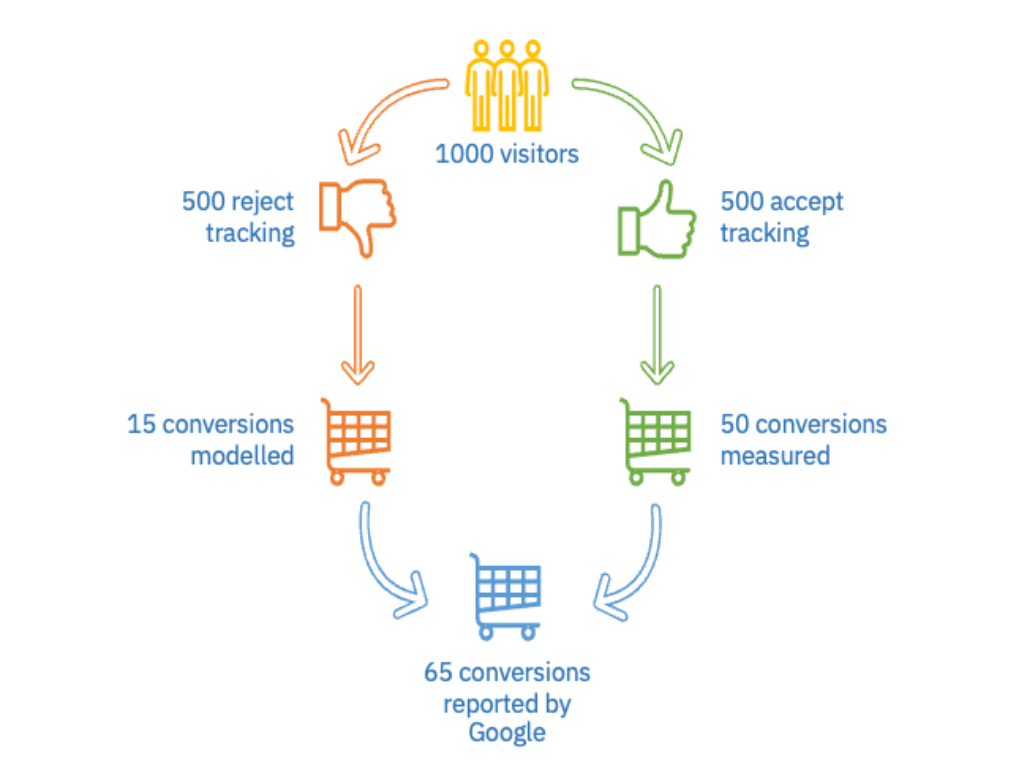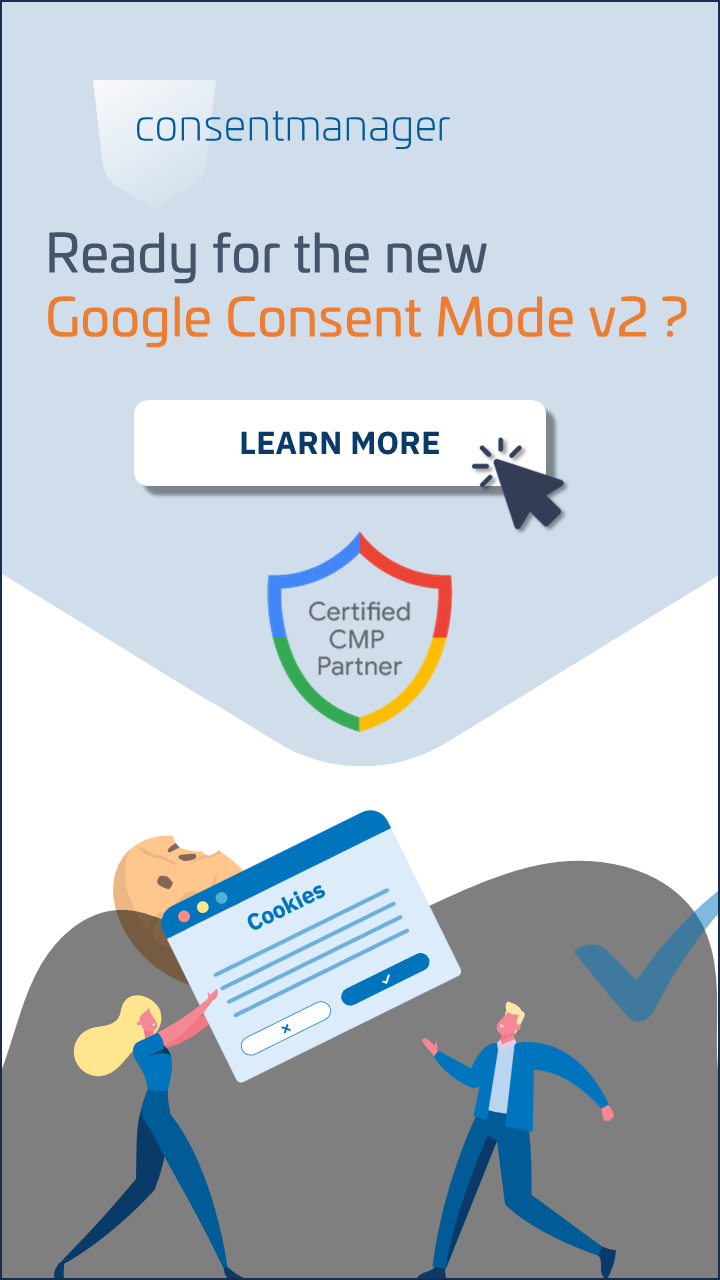Google Consent Mode v2
Mandatory for websites and apps from March 2024
Google requires all websites and apps to use Google Consent Mode v2 from March 2024 . A CMP certified by Google is then important. With the integrated Consent Mode v2, consentmanager helps advertisers to collect their customers’ conversion data while protecting their privacy. consentmanager offers you, among other things:
- Google certified CMP
- Full support for Google Consent Mode v2
- Full support for IAB TCF 2.2
- For websites, apps and CTV
- +30 languages & customizable design
- Integrated crawler and more

Recommended by many e-commerce websites
Frequently asked questions about Google Consent Mode v2
To help you better understand Google Consent Mode , cookies, the GDPR and the legal use of Google services, we have summarized the most frequently asked questions for you here.
What is Google Consent Mode ?
Google Consent Mode is a feature from Google that works with the cookie banner or privacy widget on your website. This technology automatically sends signals from your cookie banner to the Google tools integrated on your website. It can therefore provide data to help Google understand your website’s conversions, even under limited data protection conditions. The signals that the cookie banner sends to Google contain information about analytics, ads, personalization and data sharing. Without these signals, Google is unable to track user or e-commerce data or perform personalization. And to be able to send these signals, using a Google certified CMP is important.
How exactly does Consent Mode work?
When a user gives their consent, the consentmanager cookie banner sends the Google Consent Mode signal to the Google tags on your website and everything works as usual. If a user does not give their consent, Google limits data collection for that category of user and no longer counts. Using Google Consent Mode the cookie banner sends a signal to Google so that Google understands the user’s decision. Google then uses, among other things, conversion modeling with machine learning to make connections between specific interactions and conversion events. For advertisers, this means they will be able to better understand how their conversion goals are being tracked – thanks to modeling, this will be the case even if the visitor has not consented.
What is the update for Google Consent Mode v2? And what is EUUCP?
All publishers and advertisers who place ads in the European Economic Area and use Google’s services will in future be subject to the “Google European Union User Consent Policy” or EUUCP. Google thus dictates to website operators how Google services may be used in terms of data protection. The most important regulation: From March 2024, websites will be required to a consent banner from, for example a Google certified Consent Management Platform (CMP) and to use Google Consent Mode v2. Furthermore, Google’s behavior when counting advertising campaigns (e.g. tracking orders) is changing: counting only happens if the user has given their consent and the corresponding signal was sent back to Google via Google Consent Mode v2. If you want to measure conversions in the future, a certified CMP with Google Consent Mode v2 is important.
- So that you don’t miss any important updates, subscribe to our newsletter .
Google Consent Mode Comparison
The most important differences between the old and the new Google Consent Mode v2 at a glance:
Old Google Consent Mode
🔴 Google Consent Mode is optional and is used to enable modeling
🔴 Using a Google certified consent management platform is optional
🔴 Counting happens when the user has given their consent, either through Google services or other third-party services
Google Consent Mode v2
✅ Google Consent Mode is required for tracking
✅ Using a Google-certified consent management platform is now mandatory . The implementation period runs until March 2024 .
✅ Counting only takes place if the user has given his consent and the corresponding signal has been sent back to Google via the Google Consent Mode
Recommended by lawyers and data protection officers
Who is Google Consent Mode (GCM) relevant for?
Google Consent Mode is relevant for publishers, advertisers, marketing agencies, web agencies and companies that implement consent banners and use Google Analytics or Google Ads.
Advertisers
Advertisers can effectively track the performance of their ads. Learn more about ad campaign spending and optimize your ad bidding strategies.
Digital marketers, agencies
Online marketers who need to obtain user consent for advertising and analytics can use Consent Mode and continue to collect important data. This leads to better performance marketing results.
Website operators who set Google Ads or Analytics on their website
For website owners, this means a better understanding of the user journey through more aggregated data about conversions on their website.
How does this conversion modeling work?
Google Consent Mode v2 offers a number of new optimizations to get the most out of your Ads campaigns. These include in particular:
- Behavioral modeling in Google Analytics 4
Google uses AI to recreate the behavior of users who have not agreed to Analytics cookies and compares this with users who have agreed to Analytics cookies. This makes more data available in GA4. - Conversion modeling in Google Analytics 4 and Google Ads
Conversions (e.g. orders or newsletter registrations) from users who have not consented are modeled based on experiences with other users. This means more conversions will be visible in GA4 and Google Ads.

On average Consent Mode recovers around 65% of the conversions that would have been lost without Consent Mode if the user’s consent had not been given. This data point highlights the effectiveness of the conversion modeling approach in recovering lost conversions without explicit consent. However, advertisers must be aware that a minimum number of 100 ad clicks per day is required to use modeling. Therefore, advertisers should ensure that their advertising campaigns reach this threshold.
Users of Google Consent Mode v2 also have the option to choose between the options ‘Advanced’ (without blocking) and ‘ Basic ’ (with “hard” blocking) within Google Consent Mode . By choosing between these options, advertisers can tailor their user consent and tracking settings to their specific privacy needs.
PDF download: Google Consent Mode v2
Get your free summary now – click here!
Advantages for advertisers
Higher data quality
Only with Google Consent Mode can you track and measure all your data. Built-in conversion modeling allows you to additionally track data lost due to user consent selection. Conversion modeling is used to close these data gaps.
Better compliance
Google Consent Mode v2 can help websites better comply with GDPR and ePrivacy . Since Google has been selected as one of the “gatekeepers” for the new Digital Markets Act enforced by the European Commission, higher data protection requirements must be implemented here. Google Consent Mode v2 is therefore required by Google for all visitors/app users from the EEA + UK (regardless of the country of the website or app owner).
Easy integration
Google Consent Mode can be used with the following Google services.
- Google Ads (including Google Ads conversion tracking and remarketing)
- Google Analytics
- Google Floodlight
- Google Conversion Linker
- Use a Google certified CMP
Please note that according to Google’s requirements, it is important to use a Google certified CMP that supports Google Consent Mode v2.
How to enable Google Consent Mode v2
This is very easy with consentmanager . Simply follow this video step by step through your consentmanager dashboard. With just a few settings, you have already activated Google Consent Mode and made your website or app fully compliant with the law. Click here for a detailed description of each step.
LEGAL FRAMEWORK
Which legal framework is relevant for Google Consent Mode ?
Not all data protection laws around the world are relevant to the use of Google Consent Mode , but in general, data protection laws that impose significant requirements on websites and companies regarding how they collect, process and handle user data are relevant to Google Consent Mode . Therefore, companies that comply with these regulations should urgently review the use of Google Consent Mode :
General Data Protection Regulation (GDPR) & ePrivacy Regulation
This data protection law applies throughout the European Union, even if companies are not necessarily based in the EU but have customers or visitors in the EU. The GDPR or its “sister”, the ePrivacy Regulation, requires website users to give their explicit, informed consent to data processing in certain cases.
EU User Consent Directive (EUUCP)
The EU User Consent Policy (EUUCP) is a Google policy that requires users of Google services to disclose the use of cookies on their website or app and to obtain consent from end users in the European Economic Area and the United Kingdom. This policy reflects the requirements of the two main European data protection laws, the General Data Protection Regulation (GDPR) and the ePrivacy Directive, as well as the corresponding UK data protection laws.
- Google Consent Mode helps comply with this policy by allowing publishers and advertisers to dynamically adapt the behavior of Google tags to users’ consent preferences, while ensuring that no identifiable information is transmitted to Google if consent has not been given.
Please note that using Google Consent Mode does not mean that your website/app is GDPR compliant. To determine if you are GDPR compliant, you can run a quick scan using our GDPR Compliance Scanner here.

.
What is consentmanager and how can consentmanager help your company?
consentmanager is a Google-certified CMP tool – simply speaking, a “cookie banner”. It helps you comply with all important data protection regulations worldwide. In particular, consentmanager has worked closely with Google to ensure compliance with the new Consent Mode v2 requirements and to ensure support for Consent Mode for its customers. With servers located exclusively in the EU, consentmanager is ready to support you as an advertiser in your advertising activities. With Cookie Website Scanner, your website will be notified of any privacy policy changes.
consentmanager CMP is available in over 30 languages and is suitable for companies of all types and sizes, from publishers and advertisers to marketing agencies, marketers and e-commerce operators. The extensive features of our CMP range from highly customizable banners, live reports, or an integrated crawler, to features that help you increase your cookie acceptance rate. Thanks to integrated A/B testing and optimization with machine learning, our customers typically achieve up to 15% higher acceptance rates.
consentmanager , Google partner and Google certified CMP
As a consent management platform (CMP) certified by Google consentmanager has a lot to offer you as a website operator or app developer. Our tool integrates seamlessly into Google’s services. We provide you with a user-friendly interface that gives you granular control over user consent and enables compliance with global data protection regulations. Thanks to years of experience in the ad tech industry, with regulatory authorities or standardization bodies such as the IAB, we offer customization, compliant data recording and keep pace with changing legal requirements. We offer our customers various integration options, including plugins for WordPress, Magento and Shopify, as well as comprehensive monitoring and reporting tools with over 12 dimensions and more than 30 metrics in our reporting tool.
Let consentmanager be your trusted Google CMP to help you achieve your advertising goals and maximize your cookie acceptance rates.
We have already helped more than 25,000 websites to comply with GDPR, TTDSG & ePrivacy
Our clients include some of the biggest websites and best known brands in the world.
… and many more.
Webinar video: Google Consent Mode
Learn in detail and with the help of “live” explanations from our subject matter expert how Google Consent Mode v2 works and how you can use it to secure your advertising revenue. Together you will go through the legal basics and learn how you can adapt them to the processes and size of your company.
frequently asked Questions
Not sure if you need a CMP?
To help you with things like GDPR, CMP and consent, we’ve rounded up the most common questions here.
The new Google Consent Mode v2 is a technology to send the visitor’s decision to the Google codes built into your website. It enables better data collection such as so-called conversion modeling.
The implementation of Google’s Consent Mode can be done with a few lines of code above the Global Site Tag or the Tag Manager Container. If you’re looking for ways to comply with privacy regulations and measure conversions, you’ve come to the right place. Get more accurate reports and ensure you maximize your advertising investments. Visit our implementation page for step-by-step instructions.
Yes, if you collect and process user data and serve Google ads to users in the European Economic Area, you must enable Consent Mode to continue collecting audience data.
To check whether Google Consent Mode is activated, you can use our free website crawler. Simply enter your website URL here and scroll to the bottom of the crawler results, where you can see if Google Consent Mode is enabled.
Google Consent Mode is GDPR compliant, but you should know that this is not the only action you need to take to be fully GDPR compliant. To find out what requirements you need to meet and whether your website passes the compliance test, try our free scanner.
According to the General Data Protection Regulation (GDPR), the user’s express consent is not required for certain data processing. This includes data processing for legitimate interests, contractual needs, legal obligations, vital interests, public tasks and historical, statistical or scientific research. Although these legal bases do not require consent, GDPR principles such as data minimization and transparency must be adhered to and companies must keep records to demonstrate compliance.
Please note that we cannot provide legal advice. Some points of this FAQ may also change over time or be interpreted differently by courts. That’s why you should always consult your lawyer!







































































































































































































